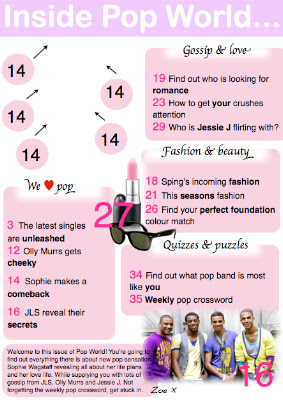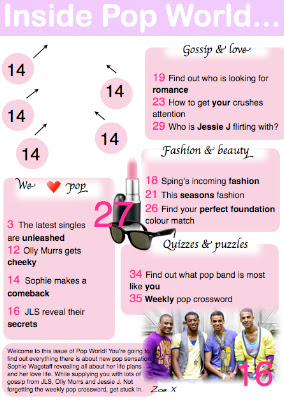View more presentations from zoerichardson
I made sure that when it came to my magazine it had a certain purpose, otherwise known as the function. I wanted to make sure it had this as I feel it would be more meaningful and would gain more interest. I maintained this by structuring the work so the readers could easily find the same features in the magazine each week. I've included a real life story which will be included in every issue. The function of my magazine was that it supplied readers with all the latest news about my featured pop artists.
APPLYING THIS TO THEORY.
Obviously before creating my preliminary task, I hadn't been taught a lot of theory information which I think affected the quality of it. Throughout the course of the project I have learnt how to apply this theory to the genre of pop and it has helped me achieve my final product.
Four Fs.
When it came to making my end product, I took all of the different categories (format, function, frames, formula) into consideration to make my product look professional.
I made sure that the format of the magazine was bright and cheerful so when people thought about it, it would portray happy and joyful thoughts. I also wanted it look look appealing to my target audience, therefore I made it look girly by adding swirly fonts and adding love heart symbols where appropriate.
I made sure that the format of the magazine was bright and cheerful so when people thought about it, it would portray happy and joyful thoughts. I also wanted it look look appealing to my target audience, therefore I made it look girly by adding swirly fonts and adding love heart symbols where appropriate.
I made sure that when it came to my magazine it had a certain purpose, otherwise known as the function. I wanted to make sure it had this as I feel it would be more meaningful and would gain more interest. I maintained this by structuring the work so the readers could easily find the same features in the magazine each week. I've included a real life story which will be included in every issue. The function of my magazine was that it supplied readers with all the latest news about my featured pop artists.
I made sure that the frames of my magazine were kept equal throughout for it to look neat and stylish. This included lining up all text in the same place for it to look equal and 'stylish' and so it doesn't look untidy.
When it comes to the formula I made sure that I included many conventional features so that I could continue to use them in upcoming issues in order from them to look similar. Another part of this would have to be the colours and fonts. I think it would be useful to stick to the same ones in other issues for it to show continuity. All of these features had a set placed in order for them to look right and to prevent the magazine from looking untidy.
Obviously as we hadn't been taught this before the preliminary task was set, I couldn't incorporate the features into it.
During the process of the main task I also learnt that I'm now a gate keeper.
"A gatekeeper is a person who controls access to something"
-Wikipedia
As I designed all of the content in my magazine, i have limited the information on what my readers find out about; this allows me have power and control over my audience.
As I have said in the presentation above, I have learnt a lot of terminology and theories. One key theory which helped me a lot was ideologies. the basis of ideology states that everything generates different thoughts and overtime is becomes a set idea or belief. I took this into account through the creation of my main task as I carried out secondary research in order to get clear ideas on what people associate pop music with. I found that people find pop lyrics are mainly to do with love and relationships and generally create a positive vibe. I incorporated all this information into my magazine so readers could clearly identify that it was to do with pop.
The ways in which I included this in my magazine and therefore represents ideologies is by creating several sell lines based on love, crushes, secrets and relationships. This is reinforced by a 'Love Special' teaser which informs readers that the topic of love is featured inside.
Ways in which I heightened the positive vibes is by using bright bold colours throughout.
During the process of the main task I also learnt that I'm now a gate keeper.
"A gatekeeper is a person who controls access to something"
-Wikipedia
As I designed all of the content in my magazine, i have limited the information on what my readers find out about; this allows me have power and control over my audience.
As I have said in the presentation above, I have learnt a lot of terminology and theories. One key theory which helped me a lot was ideologies. the basis of ideology states that everything generates different thoughts and overtime is becomes a set idea or belief. I took this into account through the creation of my main task as I carried out secondary research in order to get clear ideas on what people associate pop music with. I found that people find pop lyrics are mainly to do with love and relationships and generally create a positive vibe. I incorporated all this information into my magazine so readers could clearly identify that it was to do with pop.
The ways in which I included this in my magazine and therefore represents ideologies is by creating several sell lines based on love, crushes, secrets and relationships. This is reinforced by a 'Love Special' teaser which informs readers that the topic of love is featured inside.
Ways in which I heightened the positive vibes is by using bright bold colours throughout.
















